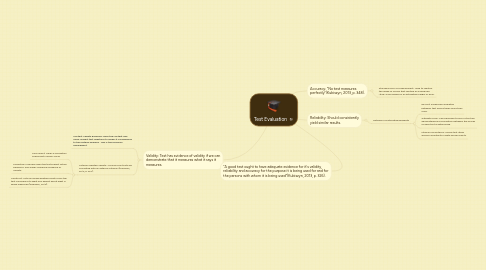Test Evaluation
by Shandee Trevino


1. Validity: Test has evidence of validity if we can demonstrate that it measures what it says it measures.
1.1. Content Validity Evidence: Does the content look valid? Inspect test questions to assess it corresponds to the material properly. This is the minimum requirement.
1.2. Criterion Related Validity: "Scores from tests are correlated with an external criterion"(Kubiszyn, 2013, p. 327).
1.2.1. Concurrent: Yields a correlation coefficient numeric value.
1.2.2. Predictive: How well does the test predict future behavior? Also yields numerical evidence of validity.
1.2.3. Construct: Lets you know whether results from the test correspond to what you expect about what is being measured (Kubiszyn, 2013).
2. "A good test ought to have adequate evidence for it's validity, reliability and accuracy for the purpose it is being used for and for the persons with whom it is being used"(Kubiszyn, 2013, p. 326).
3. Accuracy: "No test measures perfectly"(Kubiszyn, 2013, p. 348).
3.1. Standard Error of Measurement: Used to identify the range of scores that capture an individuals "true" score based on an estimated margin of error.
4. Reliability: Should consistently yield similar results.
4.1. Methods of Estimating Reliability
4.1.1. Re-rest: Assessing correlation between test scores taken more than once.
4.1.2. Alternate Form: Two equivalent forms of test are administered and correlation between the scores of each test is determined.
4.1.3. Internal Consistency: Similar test items should consistently create similar results.

